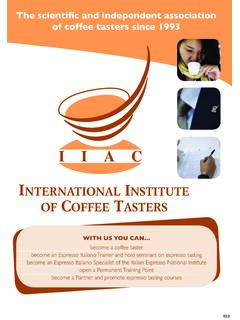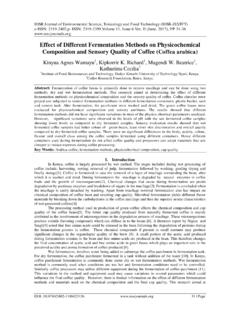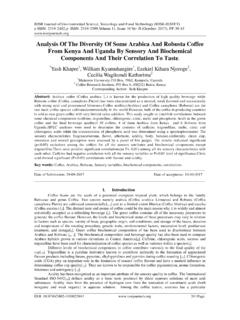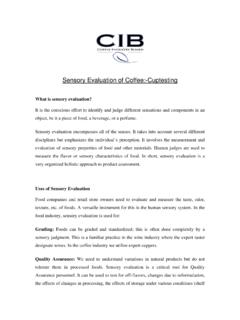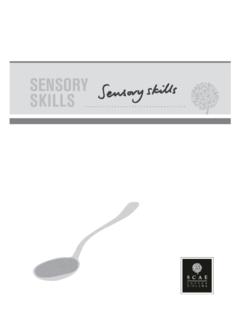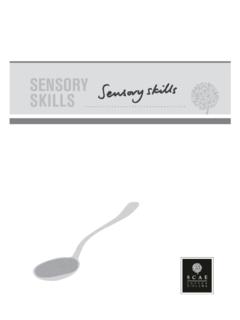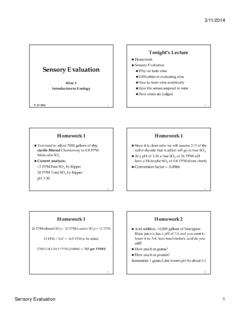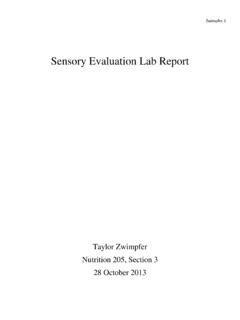Transcription of Sensory evaluation - Jones & Bartlett Learning
1 CHAPTER 3 Sensory evaluation Sung Eun Choi, PhD, RD Chapter objectives THe STuDenT wIll be emPowereD To: Identify the Sensory characteristics of food. Discuss the factors affecting the outcomes of Sensory evaluation . Demonstrate an understanding of the process for Sensory evaluation tests. Formulate an effective Sensory evaluation strategy by selecting appropriate test design, panelists, and instruments. Discuss how to analyze and interpret the Sensory data and recognize specifi c methodological advances related to Sensory evaluation . Pixland/ 8329/12/12 11:36 PM Jones & Bartlett Learning , LLC. NOT FOR SALE OR DISTRIBUTION. Jones & Bartlett Learning , LLCNOT FOR SALE OR DISTRIBUTION Jones & Bartlett Learning , LLCNOT FOR SALE OR DISTRIBUTION Jones & Bartlett Learning , LLCNOT FOR SALE OR DISTRIBUTION Jones & Bartlett Learning , LLCNOT FOR SALE OR DISTRIBUTION Jones & Bartlett Learning , LLCNOT FOR SALE OR DISTRIBUTION Jones & Bartlett Learning , LLCNOT FOR SALE OR DISTRIBUTION Jones & Bartlett Learning , LLCNOT FOR SALE OR DISTRIBUTION Jones & Bartlett Learning , LLCNOT FOR SALE OR DISTRIBUTION Jones & Bartlett Learning , LLCNOT FOR SALE OR DISTRIBUTION Jones & Bartlett Learning , LLCNOT FOR SALE OR DISTRIBUTION Jones & Bartlett Learning , LLCNOT FOR SALE OR DISTRIBUTION Jones & Bartlett Learning , LLCNOT FOR SALE OR DISTRIBUTION Jones & Bartlett Learning , LLCNOT FOR SALE OR DISTRIBUTION Jones & Bartlett Learning , LLCNOT FOR SALE OR DISTRIBUTION Jones & Bartlett Learning , LLCNOT FOR SALE OR DISTRIBUTION Jones & Bartlett Learning .
2 LLCNOT FOR SALE OR DISTRIBUTION Jones & Bartlett Learning , LLCNOT FOR SALE OR DISTRIBUTION Jones & Bartlett Learning , LLCNOT FOR SALE OR DISTRIBUTION Jones & Bartlett Learning , LLCNOT FOR SALE OR DISTRIBUTION Jones & Bartlett Learning , LLCNOT FOR SALE OR DISTRIBUTIONI ntroductionDetermining how food products affect consumers senses is one of the most important goals of the food industry. It also is a primary concern for nutrition-ists and dietitians who develop healthier recipes. Because our five senses act as the gatekeeper of our bodies, the benefits of healthy food will be reaped only if our senses accept it. Therefore, consumer reaction, as perceived by the five senses, is considered a vital measure of food development. Because no apparatus can substitute for the senses in evaluating food, humans are used as test subjects. Such studies are becoming more prevalent, despite the potential biases of humans and the costs evaluation is a scientific method that evokes, measures, ana-lyzes, and interprets responses to products, as perceived through the senses of sight, smell, touch, taste, and This widely accepted definition is used by Sensory evaluation committees within various professional organizations, including the Institute of Food Technologists and the American Society for Testing and Like other scientific methods of taking measurements, Sensory evaluation is concerned with precision, accuracy, and sensitivity and with avoiding false-positive Reliable Sensory evaluation is based on the skill of the Sensory analyst in optimizing four factors: definition of the problem, test design, instrumentation, and interpretation of the results:4,5 Definition of the problem: The item to be measured must be defined precisely.
3 Test design: Not only must the design take into account unknown sources of bias, but it also must minimize the amount of testing required to produce the desired accuracy of the results. Instrumentation: The panelists must be selected and trained to give a reproducible result. Interpretation of the results: The analyst should select appropriate statistics based on the correct statistical assumptions and draw only those conclusions that are supported by the benefits of well-performed Sensory evaluation can be realized in many ways; however, if the Sensory analyst fails to optimize one of the four factors, much time and money is wasted. For effective Sensory evaluation , the analyst should duly recognize the purpose of the study, select the appropriate experimental design, use panelists who fit the purpose, choose the proper method for preparing and presenting the samples, and analyze the data cor-rectly.
4 A Sensory researcher should always consider whether the method is appropriately implemented and whether errors have been introduced at any stage of the this chapter, the principles of Sensory evaluation will be introduced. Examples will be provided to demonstrate the use of Sensory evaluation techniques and the application of the results toward developing and modify-ing food Human SensesThe characteristics of food are perceived by the five senses: sight, smell, taste, sound, and eyes perceive the initial quality of food, receiving such information as color, size, shape, texture, consistency, and opacity. Light entering the lens of the eye is focused on the retina, where the rods and cones convert it to neural Sensory evaluation The scientific measurement method of food quality based on Sensory characteristics as perceived by the five Chapter 3 Sensory 8429/12/12 11:36 PM Jones & Bartlett Learning , LLC.
5 NOT FOR SALE OR DISTRIBUTION. Jones & Bartlett Learning , LLCNOT FOR SALE OR DISTRIBUTION Jones & Bartlett Learning , LLCNOT FOR SALE OR DISTRIBUTION Jones & Bartlett Learning , LLCNOT FOR SALE OR DISTRIBUTION Jones & Bartlett Learning , LLCNOT FOR SALE OR DISTRIBUTION Jones & Bartlett Learning , LLCNOT FOR SALE OR DISTRIBUTION Jones & Bartlett Learning , LLCNOT FOR SALE OR DISTRIBUTION Jones & Bartlett Learning , LLCNOT FOR SALE OR DISTRIBUTION Jones & Bartlett Learning , LLCNOT FOR SALE OR DISTRIBUTION Jones & Bartlett Learning , LLCNOT FOR SALE OR DISTRIBUTION Jones & Bartlett Learning , LLCNOT FOR SALE OR DISTRIBUTION Jones & Bartlett Learning , LLCNOT FOR SALE OR DISTRIBUTION Jones & Bartlett Learning , LLCNOT FOR SALE OR DISTRIBUTION Jones & Bartlett Learning , LLCNOT FOR SALE OR DISTRIBUTION Jones & Bartlett Learning , LLCNOT FOR SALE OR DISTRIBUTION Jones & Bartlett Learning , LLCNOT FOR SALE OR DISTRIBUTION Jones & Bartlett Learning .
6 LLCNOT FOR SALE OR DISTRIBUTION Jones & Bartlett Learning , LLCNOT FOR SALE OR DISTRIBUTION Jones & Bartlett Learning , LLCNOT FOR SALE OR DISTRIBUTION Jones & Bartlett Learning , LLCNOT FOR SALE OR DISTRIBUTION Jones & Bartlett Learning , LLCNOT FOR SALE OR DISTRIBUTION impulses that travel to the brain via the optic Perception by the visual system of light of wavelengths 400 500 nanometers (nm; blue), 500 600 nm (green and yellow), and 600 800 nm (red) is commonly expressed in terms of the hue, value, and chroma of the Munsell color may accurately indicate ripeness, strength of dilution, and the degree to which the food has been heated. Color is used to evaluate a food s desirability and acceptability. Greenish bananas, burnt meat, and dark brown avocado send visual signals that can change a person s choices. Color often triggers certain expectations in the mind; for example, the creamy color of vanilla ice cream evokes an expectation of , color can be deceiving.
7 The quality of food can be masked by changes in color. For instance, if yellow coloring is added to a food without actual fat having been added, the quality of low-fat products can be improved. Color changes alone can increase a food s acceptability small visual details such as adjacent or background colors and the relative sizes of areas of contrasting color can affect a consumer s perception. Parameters of size and shape, such as width, length, thickness, particle size, geometric shape, and distribution of pieces, also provide information on food quality. The dullness, shininess, smoothness, or roughness of a surface and the clarity of liquids evoke preconceptions about the food. See Special Topic for more information on some of the latest trends chefs use to create dishes that delight the Topic GastronomySarah ChurchillThe concept of molecular gastronomy was founded by Herv This, editor at Pour la Science, and Nicholas Kurti, a low-temperature physicist.
8 They coined the term molecular gastronomy to encompass all the physical and chemical changes that occur during food production and cooking. In an effort to identify the methods for creating the best flavor and texture, they compared existing recipes with old proverbs and old wives In 1992, they established the first international Workshop on Molecular and Physical The workshop still takes place today; however, the field of molecular gastronomy has moved from the scientific realm into the media limelight, becoming a cultural , popular culture uses the term molecular gastronomy to refer to the way modern chefs innovate with ingredients and techniques to bring excitement to the dining experience. The practice of molecular gastronomy also has been referred to as culinary constructivism, experimental cuisine, molecular cooking, modernist cuisine, culinary deconstructivism, and progressive cuisine. For example, the modern chefs Ferran Adri of el Bulli, Heston Blumenthal of The Fat Duck, and Grant Achatz of Alinea are attempting to understand the chemical and physical nature of cooking as well as the best ingredients and techniques to improve upon traditional methods.
9 They accomplish these goals through the deconstruction of certain recipes, the transformation of the physical states of foods ( , gases, liquids, solids), and the use of different equipment and ingredients to change cooking chefs do not necessarily ascribe their innovations to molecular gastronomy, however. Adri and Blumenthal say they go beyond the mere scientific exploration promoted by This and Kurtis. They also dispute the claim that the cuisine they are creating is pure novelty. They explain that they view food with a certain openness and embrace new ingredients and cooking methods without forsaking tradition. They affirm that their methods help them realize the full potential of each ingredient by questioning traditions about the best way to cook a food molecular gastronomy Form of modern gourmet cooking that seeks to identify all the physical and chemical changes that occur during food production and cooking to create the best flavor and Human SenSeS 8529/12/12 11:36 PM Jones & Bartlett Learning , LLC.
10 NOT FOR SALE OR DISTRIBUTION. Jones & Bartlett Learning , LLCNOT FOR SALE OR DISTRIBUTION Jones & Bartlett Learning , LLCNOT FOR SALE OR DISTRIBUTION Jones & Bartlett Learning , LLCNOT FOR SALE OR DISTRIBUTION Jones & Bartlett Learning , LLCNOT FOR SALE OR DISTRIBUTION Jones & Bartlett Learning , LLCNOT FOR SALE OR DISTRIBUTION Jones & Bartlett Learning , LLCNOT FOR SALE OR DISTRIBUTION Jones & Bartlett Learning , LLCNOT FOR SALE OR DISTRIBUTION Jones & Bartlett Learning , LLCNOT FOR SALE OR DISTRIBUTION Jones & Bartlett Learning , LLCNOT FOR SALE OR DISTRIBUTION Jones & Bartlett Learning , LLCNOT FOR SALE OR DISTRIBUTION Jones & Bartlett Learning , LLCNOT FOR SALE OR DISTRIBUTION Jones & Bartlett Learning , LLCNOT FOR SALE OR DISTRIBUTION Jones & Bartlett Learning , LLCNOT FOR SALE OR DISTRIBUTION Jones & Bartlett Learning , LLCNOT FOR SALE OR DISTRIBUTION Jones & Bartlett Learning , LLCNOT FOR SALE OR DISTRIBUTION Jones & Bartlett Learning .










